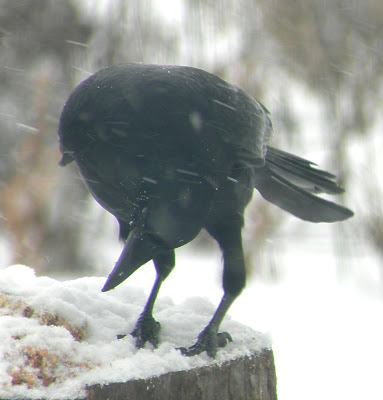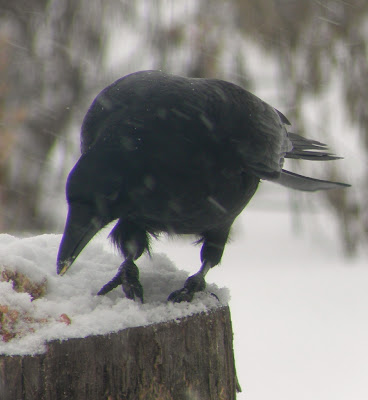 Photo by Francois Portmann http://www.fotoportmann.com/birdblog/
Photo by Francois Portmann http://www.fotoportmann.com/birdblog/
Monday, Valkyrie of Tompkins Square Park gives Francois the eye. Francois said, "She's eating leftovers that were stashed under the snow."
Francois said, "She's eating leftovers that were stashed under the snow."
(Very clever. Snow not only hides her food but keeps it fresh.)
 After finishing her meal, she stands as Francois says, "...looking cute and cuddly."
After finishing her meal, she stands as Francois says, "...looking cute and cuddly." Wildlife Rehabilitator Cathy Horvath with the Red-tailed Hawk juvenile who spent weeks down an airshaft before being rescued.Lower Eastside Hawks in the News
Wildlife Rehabilitator Cathy Horvath with the Red-tailed Hawk juvenile who spent weeks down an airshaft before being rescued.Lower Eastside Hawks in the News By Patrick Hedlund
DNAinfo News Editor
EAST VILLAGE — The East Village is becoming hot real estate for a new class of upwardly mobile New Yorkers who love the neighborhood's abundant dining options — red-tailed hawks.
The recent rescue of a young hawk from an East Village building, as well as numerous sightings of the birds throughout the neighborhood, has convinced experts that the area has become a popular destination for the beloved raptors.
"Every year, the population is growing and growing," said Bobby Horvath, a Long Island-based wildlife rehabilitator, who helped rescue a fledgling red-tail hawk that got stuck in a building's air shaft on East 3rd Street earlier this month.
In the last month alone, Horvath has swooped in to save another hawk that became trapped inside the New York Times building, and yet another that got caught in an air shaft on the Upper East Side.
"It's in indicative of an increase in population," Horvath added. "The sheer number of calls that we're receiving shows that their numbers are just growing by leaps and bounds."
With its well-documented rat problem and plenty of pigeons, the East Village provides a smorgasbord for the hawks, experts said.
Green spaces like Tompkins Square Park, where red-tailed hawks have been seen regularly for years, offer even more in the way of meals due their the natural wildlife.
"To me it seems that there are even more birds this winter," said Francois Portmann, a photographer and East Village resident who started documenting hawks after observing them in Central and Tompkins Square Parks. "It looks like they're busy again [searching for mates] right now."
About three years ago, a nest of red-tailed hawks showed up on top of an air-conditioning unit on East Houston Street. Horvath was summoned there after the hatchlings fell onto the street below.
More recently, he took in a red-tail found injured in Stuyvesant Square Park, which neighbors said is a regular haunt for the hawks.
Because it's extremely difficult to tell by sight if any or all of these hawks are related, neither Horvath nor Portmann could say for sure where they hail from.
But Horvath does believe the trend could be attributed to the birds simply becoming more comfortable in the urban environment.
"If you look up any day," he said, "you can find (a hawk) in the city easier than you can on Long Island these days."
In fact, neighborhoods like the East Village may provide even better opportunities for the hawks — only about a quarter of which survive their first year — because of the wealth of food options. Horvath explained that hawks are expected to hunt for themselves once out of the nest, meaning that rat-ridden streets are sometimes their best option.
However, rodent poison and pigeon bacteria can severely hurt the birds, so it's hard to say whether city streets are just as habitable as rural areas, Portmann added. Birdwatchers mourned the loss of the beloved Upper East Side red-tailed hawk, Lola, who partnered with Pale Male for nine years, after she went missing in December.
"The problem with the urban situation is they sometimes build [nests] on ledges that have no anchors for the nest," he said, referencing the situation with the hawks on East Houston Street.
Nonetheless, Portmann has seen hawks everywhere from the Marble Cemetery on East 2nd Street to Seward Park on the Lower East Side to Washington Square Park in Greenwich Village.
Read more:http://www.dnainfo.com/20110126/lower-east-side-east-village/east-village-becoming-haven-forhawks#ixzz1CD1aLCYe
 The 2008 Tompkins Square Pair, who eventually moved on, possibly within the neighborhood, after failing to complete a tree nest in the park.Note how dark both these hawks are. Note the coloration of Valkyrie and the photo of the tiercel of the 1 Fifth Avenue pair that tops the next post down. Is there a Downtown Dark Hawk Dynasty developing? Just as there were quite a number of Pale Hawks uptown.The Washington Square Park Pair have begun a nest on a window ledge adjacent to the park. There is some concern that as there is likely nothing to anchor the twigs to and that the nest will likely not hold together in storms. We wondered if it might not be a good place for a trial of John Blakeman's Nest Nook. Here is what John had to say as the hawks have already started building their nest.
The 2008 Tompkins Square Pair, who eventually moved on, possibly within the neighborhood, after failing to complete a tree nest in the park.Note how dark both these hawks are. Note the coloration of Valkyrie and the photo of the tiercel of the 1 Fifth Avenue pair that tops the next post down. Is there a Downtown Dark Hawk Dynasty developing? Just as there were quite a number of Pale Hawks uptown.The Washington Square Park Pair have begun a nest on a window ledge adjacent to the park. There is some concern that as there is likely nothing to anchor the twigs to and that the nest will likely not hold together in storms. We wondered if it might not be a good place for a trial of John Blakeman's Nest Nook. Here is what John had to say as the hawks have already started building their nest.Donna,
If the Nest Nook is placed on a wide ledge, as the nest structure at The Franklin Institute in Philadelphia, there is no need for any protruding landing or fledging poles (the things I will be added to the Nest Nook design).
If the hawks can land and walk out onto a 2- or 3-ft of adjacent ledge, all works well. This exactly parallels the hundreds of Red-tail nests on Western cliffs. And this worked perfectly for the Philadelphia eyasses last year, once again.
So if the ledge is wide, not just a narrow window sill, the Nook will be entirely sufficient.
And if a Nook were quickly built and placed on the ledge, right where the sticks are being placed, the hawks would INSTANTLY take it up if the sticks were placed in the bowl of the Nest Nook. The hawks would think they put them there, and would then go on to complete the enter nest.
Sincerely,
John A. Blakeman
AND THE COOPER'S HAWK IN THE LIBRARY OF CONGRESS IS RESCUED!All is well, thanks to ingenuity and a couple of starlings:
http://magblog.audubon.org/hawk-trapped-library-congress-captured-full-recovery-expected
Best wishes,
Jackie Dover, in OklahomaDonna Browne




















































